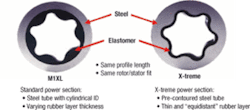Mærsk Oil & Gas extends drilling envelope
Integration of performance drilling motor, rotary steerable system
Hans-Henrik Rønnau, Peter Vilhelm Balslev, Mærsk Oil & Gas AS
Jon Ruszka, Carl Clemmensen, Sverre Kallevig, Ralf Grosspietsch, Georg Mader,Inteq
Mærsk Oil & Gas has implemented a new system that integrates a specially designed drilling motor within a high speed rotary steering assembly. This new system has mitigated many of the challenges of continuous rotary drilling and the existing drilling envelopes can be extended to further improve field recovery.
Since their introduction in 1997, rotary steerable drilling systems have delivered significant gains in drilling efficiency. In addition to this fundamental benefit, these systems have enabled more challenging wells to be drilled at low risk with a wide range of other advantages, including improved well placement, etc.
Mærsk operations include the development of several chalk reservoirs in the Danish sector of the North Sea. The reservoirs are located at approximately 6,700 ft true vertical depth (TVD) and are drained through the use of horizontal wells. Productivity from these horizontal wells is largely dependent on the 3D precision with which the wellbores are positioned within the chalk and the length of reservoir exposed.
Prior to the introduction of rotary steerable assemblies, the company’s conventional directional drilling techniques were employed on the fields. Using steerable motor assemblies, the limitations of steerability of these systems restricted horizontal reach to approximately 16,000-ft measured depth rotary table (MDRT) and TVD control to +/- 5 ft.
To extend the reach of the wells and allow vertical wellpath position control, operators would run adjustable stabilizers in conjunction with the steerable motors. This gave an increase in the length of horizontal section past the sliding limit of the conventional system but wellpath position control was only possible in the vertical plane with no control in the lateral plane. Using adjustable stabilizers with motors allowed wells to be drilled with reach of 22,000 ft MDRT.
Rotary steerable technology was first used on these fields in 1998. The technology allowed wells to be continuously and precisely steered in 3D, giving TVD control of +/- 1 ft with full azimuth control and for the wells to be drilled as far as 28,000 ft reach. The limits of how far wells could be drilled using the rotary steerable system were now related to wellbore/drillstring friction increasing to the point where only little of the rotary power delivered by the rig top drive system was reaching the drillbit.
Limitations
With increased choices of “how” to drill, drilling engineers are faced with more decisions on what method to select. Their decision varies not only for each hole section but can also vary within each hole section and different drilling methods are sometimes used even within single sections of hole.
When the operator is rotary drilling, all of the mechanical power required by the bit to cut the rock is provided from the rig rotary system. As the reach of wells increases and more geometrically complex wells are drilled, more energy is lost through borehole friction and damaging torsional vibration of the drillstring. The energy loss results in less power being delivered to the drill bit, reducing drilling efficiency and ultimately limiting the reach in which the well could be efficiently drilled.
For the operator to achieve an acceptable ROP, rotary steerable systems are often operated toward the upper limits of rig rotary speed capability. This varies by rig capacity, but frequently involves rotating the drillstring continuously at between 130 and 180 rpm. While this very high string rotary speed is good for ROP and beneficial to hole cleaning, it can also be mechanically damaging. Operator’s existing casing strings, drillpipe and BHA components wear at higher rates and, in some areas, high and continuous drillstring rotary speed can damage the formation itself.
When the operator is using pure rotary drilling, there is no decoupling of drill bit dynamics from the BHA immediately above it. Torsional vibration (stick-slip) can be generated either by the friction of the drillstring against the borehole wall or directly by the drill bit. In the event the drillbit induces torsional vibration, this vibration is transmitted to the entire BHA as there is no decoupling or dampening as there is with the Positive Displacement Motor (PDM) assemblies.
In an attempt to overcome some of these limitations, it was decided to try and drive the rotary steerable system with a PDM.
Driving the existing rotary steerable system like this required the entire rotary steerable BHA, including non-magnetic drillpipe, to be positioned below the PDM. The length of BHA below the PDM in this configuration is approximately 80 to 110 ft, dependent upon the amount of non-magnetic drillpipe required. With such a long assembly below the PDM, higher stress is placed on it. This lowers the efficiency of the motor power to the drillbit. More importantly, however, it also increases the risk of a lost in hole incident. In the event that any of the BHA below the motor got stuck in hole, it would become more difficult to free, as no torque can be transmitted through the PDM from surface.
Due to the operator’s increased risk of lost in hole, it was determined ill-advisable to run nuclear logging tools in the BHA below the motor. These logging tools are frequently required to evaluate formation characteristics of porosity and density and are used in real-time to geosteer wells in the most productive zones.
The original rotary steerable device included rotating mud/oil seals in its design. These seals isolate electronic, hydraulic and mechanical components in the rotary steerable system from contact with the drilling fluid. As rotary speed increases, these seals wear at a higher rate and ultimately limit the life expectancy of the system.
Integrating rotary steerable assembly
The main engineering challenges were focused on reliability. Adding an additional component to a system always runs the risk of negatively impacting whole system reliability. This effect was to be minimized, if not eliminated.
Fortunately, a rotary steerable system already existed which appeared suited to be run in combination with a PDM. The selected rotary steerable system was already proven in many locations, performing in a wide variety of different drilling environments. This latest generation system is unique in many respects which include the elimination of reciprocating and rotating mud/oil seals and highly modular architecture.
With a range of different PDM systems to choose from, each was given due consideration. The pre-contoured drilling motors were already proven to deliver superior drilling performance compared to even the best “conventional” motors. The design differs significantly from conventional drilling motors since the “stator” section is pre-contoured in steel as opposed to solid molded elastomer.
The BHA base design has the motor power section located immediately above the rotary steerable steering unit device and below the MWD / LWD system. This design was decided upon as it minimized the length of BHA hanging below the motor. It also would allow use of nuclear LWD systems to be run in the BHA as they and any other sensitive LWD tools would be positioned above the motor.
Other design changes were the integration of the flexible sub and stabilizer into the motor itself plus maintaining full communication between the steering unit (positioned below the motor) and the LWD systems (above the motor) by hard wiring the motor with a communications and power BUS. This required re-engineering of the motor itself to house the data cable and incorporating the lower flex and stabilizer component into the motor itself.
Case study
Mærsk drilled the horizontal reservoir section on a Halfdan well starting in May 2002 at 8,255 ft with a standard rotary steerable assembly. However, at 22,800 ft the company ceased drilling operation due to high surface torque readings (41-44,000 ft/lbs) and a low rate of penetration (22 ft/hr). While drilling this section, attempts were made to reduce the high torque readings by adding up to 2% lubricant into the water based mud system. Since the operator’s planned TD had not been reached, an idea to include a mud motor was proposed to maximize the power to the drilling bit, and at the same time minimize the drill string revolutions to reduce both casing wear and cycle fatigue of the drill string. The operator’s concern of having a long and fairly heavy assembly hanging below the motor was discussed, but deemed possible as long as the lower part was properly centralized with the motor assembly.
The operator made a trial run with a mud motor added to the drilling assembly, which consequently required the LWD tools be left out, since these tools could not be run in the this configuration. Since the formation is very homogeneous in this field, the operator used the same bit, in order to make a proper comparison on drilling performance before and after the introduction of the mud motor. Drilling was resumed from 22,800 ft to well TD at 25,948 ft.
The operator indicated a performance improvement of the combined mud motor and the rotary steerable device with an average rate of penetration of some 86 ft/hour, which equals an improvement in rate of penetration of some 290%. This trial run proved that the theory of having power close to the bit would increase the drilling performance significantly.•
Acknowledgements
The authors would like to thank Mærsk Oil & Gas AS, its partners Shell and ChevronTexaco, and Inteq for the support and the permission to publish this paper.
Editor’s Note: This is a summary of SPE 91810 paper that was prepared for presentation at the SPE/IADC Drilling Conference held in Amsterdam, The Netherlands, Feb. 23-25, 2005.


